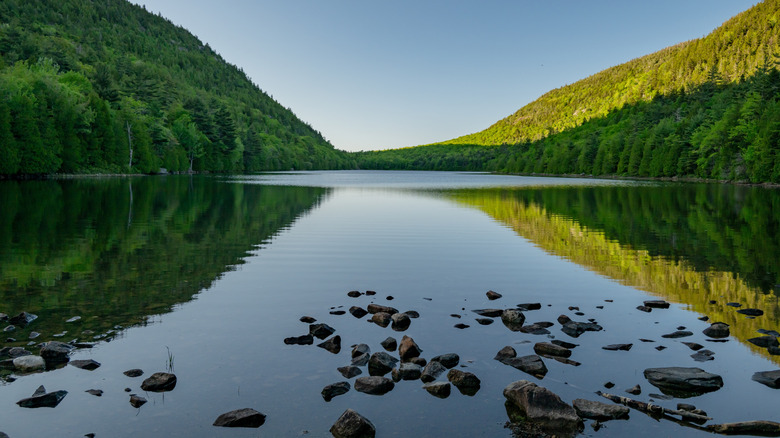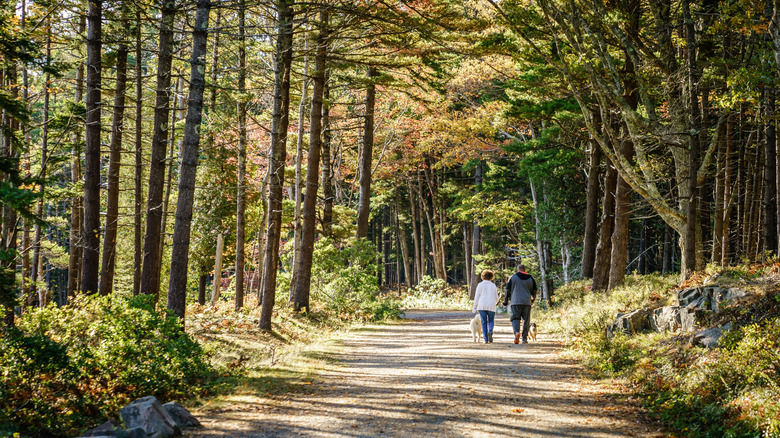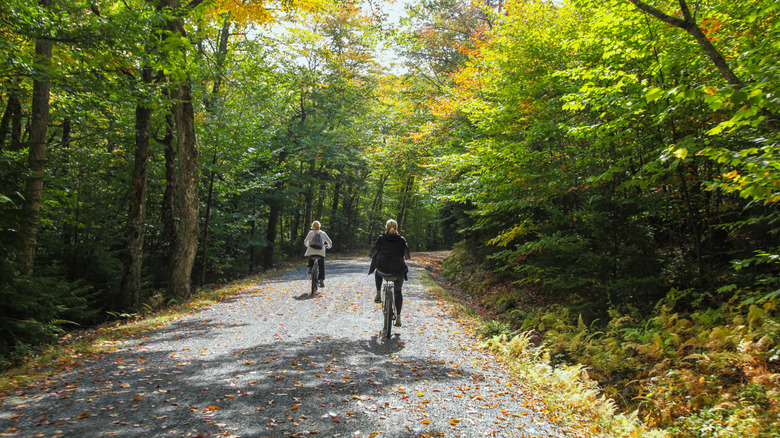The Most Scenic Road In Maine's Acadia National Park Is This Serene, Car-Free, Bike-Friendly Route
Maine's Acadia National Park is frequently at the top of lists for East Coast beauty, combining lakes, mountain trails, and ocean views in one spot. Of the many roads in the park, Acadia's historic carriage roads may just be the most scenic. Accessible by foot, horse, and bike only, the carriage roads are the only place in the park where you won't be interrupted by oncoming traffic.
It's true that you can drive through Acadia National Park if you choose to. Park Loop Road essentially runs around the entirety of Mount Desert Island, making Acadia easy to see without hiking if you're unable to or are simply short on time. There are parking lots around the island so you can hop out and walk to the key points in the park, like Acadia's signature lighthouse on the rocks, or the top of Cadillac Mountain. It's also one of America's most scenic roads.
But if you're looking for miles of uninterrupted trail that don't involve a permit (or a motor vehicle), Acadia's 45 miles of carriage roads are the best route. Located almost three hours north of Portland, right outside the small town of Bar Harbor (which is routinely listed as one of America's best towns to visit), this part of the park is the perfect New England nature trip destination. Although Acadia is accessible by car, these carriage roads are meant for hikers, cyclists, skiers, snowshoers, and people on horseback (or carriage).
A trail that blends in with the natural landscape
Acadia National Park's carriage roads were originally a gift from John D. Rockefeller Jr. (who wanted to experience the park via horse) and were designed and implemented over three decades between 1913 and 1940. As of 2025, almost four million people a year use them. Sharing these trails, you'll see a mix of school groups, hikers, bikers, and horseback riders — it's important to note that with no cars on the road, horses always have the right of way. On the rocks of Mount Desert's coast, you'll get fantastic views of the ocean, but not a sense of what grows on the island. The carriage roads, which run over all kinds of terrain, are an excellent way to experience the natural flora and fauna of Maine.
"Landscape architect Beatrix Ferrand had a home here in Bar Harbor and collaborated with Rockefeller on the vistas and planting design along the carriage roads," Lisa Horsch Clark of the nonprofit organization Friends for Acadia told National Geographic. While a lot of careful planning went into creating these beautiful trails, the carriage roads are still regularly maintained and "flossed," which is how Acadia gardeners describe weeding areas with rocks named for Rockefeller's teeth. On the carriage roads, you're likely to encounter ferns, woodland wildflowers like wild blue iris and starflowers, and a blend of trees from both Eastern deciduous forests and Northern boreal forests.
Bike the park without worrying about cars
If you're an avid biker, you've likely cycled in or between two national parks before. In many national parks, bikes are restricted to the roads that cars drive on. While the paved roads of Acadia and other parks are stunning, sharing the road can be a hazard for bikers and drivers alike. At no point on the trails will you find cars; instead, you'll find many bikers rolling over the crushed rocks, which are an excellent surface for bicycle wheels.
The carriage roads run right through the center of the park, connected by 16 historic stone bridges, making them an excellent choice for seeing the main attractions via bike. The carriage roads will take you to the Visitors Center, Eagle Lake, Jordan Pond, and more — almost anywhere except the top of Cadillac Mountain, where you'll have to take the paved road almost entirely uphill should you decide to bike it. If you take this route, there's far more to see than the woods separating attractions. The 8.6-mile-long Jordan Pond Loop section of the carriage roads runs along the pond, starting at The Bubbles. This is a popular stretch to bike, with an additional 1.7-mile foot trail that runs through the woods starting on the opposite side of Jordan Pond. As with all of the carriage trails, the path blends in beautifully with the natural landscape, hugging the water as it runs through the forest. If you're looking to explore more of the National Park System, here is a complete list of every national park in America.


